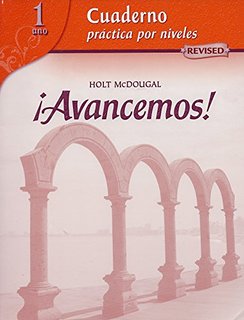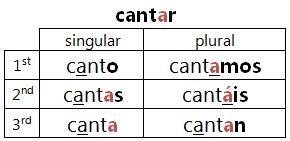
All Solutions
Page 56: Gramatica A
The objective of this exercise is to practise the use of regular verbs from the “-ar” group.
First of all, let us say that all Spanish verbs are grouped into three classes based on their infinitive ending: -ar, -er and -ir. There are regular and irregular verbs in all three groups.
Regarding the first, “-ar” group, you will notice that the vowel “a” is repeated throughout the conjuguation paradigm. Such a vowel is called a theme vowel. Later on, you will see how a theme vowel affects the verbal paradigm. A paradigm is what we call the series of conjugated forms of a verb. Refer to the below table for further clarification.
In the table, you will find the paradigm for the present tense in the indicative mood for the verb “cantar”. All verb from the “-ar” group will behave like this. Irregularities may only affect the stem. Notice the verbal endings, in bold letters: you will see that the theme vowel is repeated throughout the conjugation. It is marked in red. You will also notice that the stress, which falls on the underlined syllable, has no effect on the theme vowel.
Now you understand how to conjugate verbs from the “-ar” group. Go ahead and solve the exercise. Remember that verbs always match the grammatical features of the subject. You may refer to the below solutions for further guidance.
2. escuchamos
3. contestas
4. trabajan
The purpose of this exercise is to practise the use of verbs from the “-ar” group.
Four incomplete sentences are given in this exercise. There is a verb in its infinitive form in parentheses at the end of each sentence. You will read the sentences to understand who the subject is and then conjugate the given verb according to the grammatical subject in the present tense. You may refer to the below solutions for further guidance.
In Spanish, when you play an instrument, you “touch” it. Thus, in such contexts, you will always use the verb “tocar”.
Example 1: Quiero aprender a tocar el piano. (to play)
Example 2: Elena toca muy bien la guitarra. (plays)
2. dibujan
3. contesto
4. llegas
The purpose of this exercise is to practise writing in Spanish.
For each sentence, you are given the grammatical subject, a frequency marker and a verb. You will create a full sentence by using these elements. Remember to conjugate the verb according to the subject. You may refer to the below solutions for further guidance.
2. Fernando y Clara casi nunca montan en bici.
3. Yaliza y yo nunca sacamos malas notas.
4. Usted enseña matemáticas.

